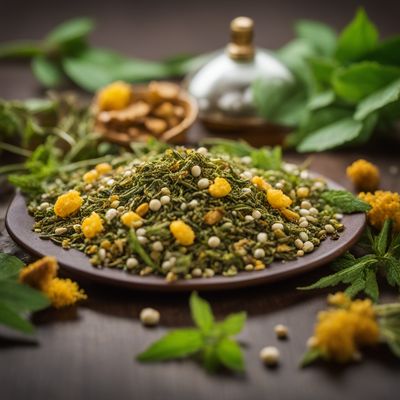
Ingredient
Herbal infusion materials from leaves and herbs
Aromatic Elixirs: Exploring the World of Herbal Infusion Materials
Herbal infusion materials, derived from leaves and herbs, encompass a diverse array of ingredients that are used to infuse beverages, oils, and culinary creations. These materials can include dried leaves, flowers, stems, and roots, each possessing unique characteristics that contribute to their taste, texture, and appearance. From the delicate floral notes of chamomile to the robust earthiness of rosemary, these infusion materials offer a world of possibilities for enhancing dishes with their natural essence.
Origins and history
The use of herbal infusion materials dates back centuries, with various cultures incorporating them into their culinary traditions and medicinal practices. Ancient civilizations such as the Egyptians, Greeks, and Chinese recognized the therapeutic properties of herbs and leaves, utilizing them for their healing benefits and aromatic qualities. Over time, these ingredients have become integral to global cuisines, with each region cultivating and utilizing its own unique selection of herbs and leaves.
Nutritional information
Herbal infusion materials are rich in antioxidants, vitamins, and minerals, providing a natural boost to overall health and well-being.
Allergens
While herbal infusion materials are generally safe for consumption, individuals with specific allergies to certain plants or herbs should exercise caution and consult with a healthcare professional if unsure.
How to select
When selecting herbal infusion materials, look for vibrant colors, intact leaves or flowers, and a strong, fresh aroma. Avoid any signs of discoloration, wilting, or mold, as these indicate poor quality.
Storage recommendations
To maintain the freshness and quality of herbal infusion materials, store them in airtight containers in a cool, dark place away from direct sunlight. This helps preserve their flavors and aromas for an extended period.
How to produce
Amateur enthusiasts can grow their own herbal infusion materials by cultivating herb gardens or potted plants. With proper care, sunlight, and watering, these plants can thrive, providing a continuous supply of fresh leaves and herbs for infusion.
Preparation tips
To prepare herbal infusions, steep the desired amount of leaves or herbs in hot water for a specified time, depending on the ingredient. Experiment with different combinations and steeping times to achieve the desired flavor intensity. Additionally, herbal infusion materials can be used to infuse oils, vinegars, or spirits, adding a unique twist to dressings, marinades, and cocktails.
Culinary uses
Herbal infusion materials are commonly used to create soothing teas, refreshing beverages, aromatic oils, and flavorful marinades. They can also be incorporated into baked goods, soups, stews, and sauces to infuse dishes with their distinct flavors.
Availability
Herbal infusion materials are widely available in grocery stores, supermarkets, and farmers markets, with a variety of options to choose from.
More ingredients from this category

Other Herbal infusion materials from leaves and herbs
Nature's Infusion: Exploring the World of Herbal Beverages

Mate and similar-
Energizing Infusion

Rooibos and similar-
Rediscovering Nature's Infusion: The World of Rooibos and Similar Herbal Teas

Strawberry infusion leaves and similar-
The Essence of Summer: Strawberry Infusion Leaves